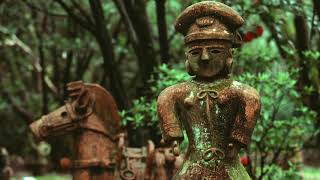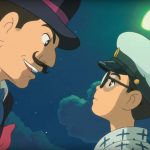Watch

Check your understanding
Vocabulary Game
Listen
More Vocabulary
Grammar
More Listening
Read
Carmen Roberts: Osaka, a modern city. Totally rebuilt after the devastation of the Second World War. Among the street crossings and skyscrapers, you can still find artifacts from its past. You might just not be able to spot them from the ground. I made it to the top. It’s a little bit of a view. It’s not bad. A lot of trees here. Not really that much to see. To get the best view of these historic wonders, you really have to take to the sky. Oh my gosh, we’re taking off. Let’s go.
Dotted across the city, there are nearly 50 grassy hills, some of them built in a distinctive keyhole shape. The Japanese called them kofun, burial mountains built over 1,500 years ago. There are so many kofun dotted all around the city. I didn’t realize the scale until you get up here and you can really see it. These man-made structures hold the remains of some of ancient Osaka’s most powerful figures. And this summer, these memorials were recognized as the city’s first UNESCO World Heritage Site.
Norio Yoshizawa: This is what the kofun looked like. They piled the earth and lay stones on top. Over 1,500 years, the trees then grew naturally over the stones.
Carmen: Yoshizawa-san has been studying the tombs for decades and was involved in the successful UNESCO bid.
Norio: This is Emperor Oju’s burial mound. The second biggest in all of Japan.
Carmen: The size and shape of burial mounds depends on the person’s status. The sites were decorated with haniwa, clay figurines that were used in the funeral ceremony.
Norio: The haniwa were placed in a circle around the deceased, so they would be protected in the afterlife. We recently excavated some haniwa, which are now being restored. I’d like you to come along and see.
Carmen: [Japanese language] Okay, let’s go.
Norio: First, they have to be washed. We observe their patterns while washing so we can use them as a reference when we put them together.
Carmen: Okay. So once they’re cleaned, what’s the next step?
Norio: They are dried outdoors.
Carmen: [Japanese language]
Norio: Then we bring them in, group them, and try to assemble them.
Carmen: Like a jigsaw puzzle.
Norio: Jigsaw. Okay.
Carmen: Haniwa take on a lot of different forms and meanings. A house like this is thought to have symbolized the person’s lifestyle. Reassembling these figures can take as long as a year.
Norio: Please, try.
Carmen: Wow, I wouldn’t know where to start with a puzzle like this. I guess, maybe?
Norio: They look very similar, close-
Carmen: Here? Maybe.
Norio: But no, that’s a shame.
Carmen: [laughs] Okay.
Norio: We are all so proud that these burial mounds have become a UNESCO World Heritage site. I can’t wait for people from all over the world to come along and see it.
479 Words
Summary
Find the Words
Useful Expressions
modern 近代の/近代的な
Osaka, a modern city.
devastation 荒廃/惨害
the Second World War 第二次世界大戦
Totally rebuilt after the devastation of the Second World War.
among ~に囲まれて
street crossing 横断歩道
skyscraper 超高層ビル
artifact 人工遺物/文化遺物
Among the street crossings and skyscrapers, you can still find artifacts from its past.
spot 見つける
You might just not be able to spot them from the ground.
view 景色/眺め
historic 歴史的に有名な/歴史上有名な
historic wonders 歴史的な不思議
To get the best view of these historic wonders, you really have to take to the sky.
take off 出発する
Oh my gosh, we’re taking off.
dotted 点在する
grassy hill 草が茂った丘
distinctive 独特の
Dotted across the city, there are nearly 50 grassy hills, some of them built in a distinctive keyhole shape.
burial mountain 埋葬山
The Japanese called them kofun, burial mountains built over 1,500 years ago.
man-made 人工の
structure 建造物
remain 遺跡
powerful figure 実力者
These man-made structures hold the remains of some of ancient Osaka’s most powerful figures.
memorial 記念物
recognise 認識する
World Heritage Site 世界遺産
And this summer, these memorials were recognized as the city’s first UNESCO World Heritage Site.
tomb 古墳
decade 10年間/10年
be involved in ~に携わる
bid 落札
Yoshizawa-san has been studying the tombs for decades and was involved in the successful UNESCO bid.
burial mound 古墳
This is Emperor Oju’s burial mound.
status 身分
The size and shape of burial mounds depends on the person’s status.
be decorated with ~で飾られている
figurine 置物
funeral ceremony 葬式
The sites were decorated with haniwa, clay figurines that were used in the funeral ceremony.
deceased 故人
afterlife 来世
The haniwa were placed in a circle around the deceased, so they would be protected in the afterlife.
excavate 掘り起こす
be restored 復元される
We recently excavated some haniwa, which are now being restored.
observe 観察する
reference 参考
We observe their patterns while washing so we can use them as a reference when we put them together.
assemble 組み立てる
Then we bring them in, group them, and try to assemble them.
take on 帯びる/もつ
Haniwa take on a lot of different forms and meanings.
symbolize 象徴する
A house like this is thought to have symbolized the person’s lifestyle.
That’s a shame. 残念です。
Carmen: Here? Maybe.
Norio: But no, that’s a shame.
Carmen: [laughs] Okay.




Comments
0 comments